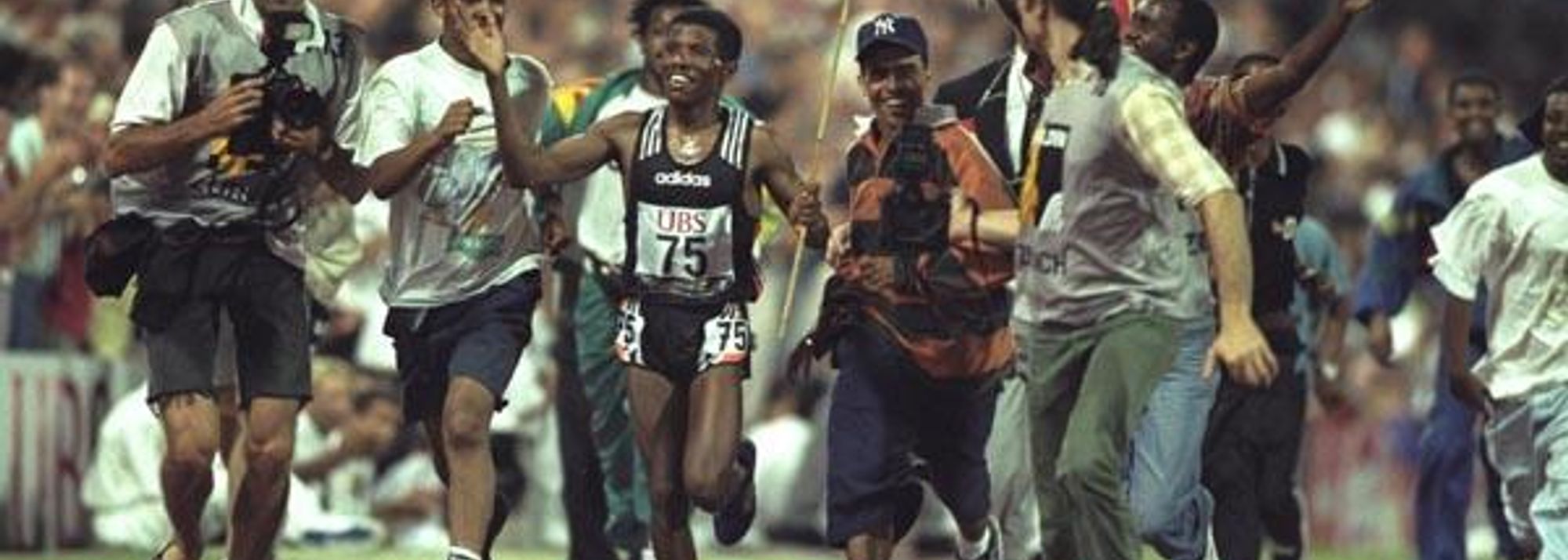Haile Gebrselassie's 12:41.86 World record at Letzigrund - 13 August 1997 (© Getty Images)
Haile Gebrselassie will run the 2000m indoors on Sunday, in Birmingham (GBR), and is aiming to set a new world record for the distance.
Assuming that the Ethiopian’s form is as good as on 25 January, when he set the indoor world record in the 3000m with 7:26.14, this should be an easy target. So easy as to lead us to believe that Gebrselassie’s real objective is, more than the long-standing 4:54.07 mark set by Ireland’s Eamon Coghlan in Inglewood on 20 February 1987, the outdoor mark over the same distance of 4:47.88 which Algerian Noureddine Morceli set in Paris on 3 July 1995.
If the truth be known, Gebrselassie has already flirted with the best indoor performance in the 2000m, when running the 3000m in Karlsruhe: he actually passed the 2000m mark in 4:57.51 - 4th fastest time ever, after Coghlan, Venuste Nyongabo (BUR) and Jens-Peter Herold (GER) - and followed this with another 1000m in 2:28.63.
There can be no doubt that, concentrating on the shorter distance, Gebrselassie should be able to run two kilometres at an average pace of 2:25 per kilometre or faster.
What never fails to astound us is the Ethiopian’s capacity for improvement, be it in duration or in speed. Just look at his result in the 1500m in Stuttgart on 1 February, where he ran 3:31.76, just 0.58 seconds off the indoor world record set by the phenomenal Hicham El Guerrouj.
The history of Athletics is not lacking in champions of this ilk - from Paavo Nurmi (FIN) to Henry Rono (KEN) and Said Aouita (MAR) - even if, in these days of ever greater specialisation, it is held to be difficult to develop with equal efficiency anaerobic and aerobic power and the consequent muscular development.
Kenya’s Daniel Komen is of the same breed as Haile Gebrselassie, though the two champions differ in everything other than a possible ancient line of ascendancy. Morphologically, the latter is evenly proportioned, whilst the former is long-limbed. When running, Haile uses the explosive power of his feet and calves, whilst Daniel has a softer and broader stride: this explains the impression of near electric action of Gebrselassie as against the loose-limbed and flowing progress - accompanied by a rocking of the chest and head - of Komen.
Once again last Friday, during the indoor meeting in Budapest, Komen hid the effort of running the 3000m in 7:24.90, i.e. 1.24 faster than Gebrselassie, behind his habitual supple style. The theory is that athletes with long femurs will be disadvantaged when running on tight tracks like the ones used indoors; Komen - who already owns the outdoor world record in the 3000 with 7:20.67 - has given the lie to this and proven, rather, that he is an accomplished hunter with the records of Gebrselassie his prey.
Komen has the advantage over the Ethiopian of being more proficient over the fast middle distances: his personal best in the 1500 is 3:29.46 (outdoors) against Haile’s 3:31.76 (indoors); but also all the disadvantages, due to aerobic fatigue, of a larger cylinder engine, which means a greater consumption of ATP (Adenosine TriPhosphate), thus of oxygen. Of course, these natural characteristics can be corrected through training - which Daniel conducts under the watchful eye of Moses Kiptanui - so we shouldn’t be surprised if we see the 22 year old Kenyan one day contesting Paul Tergat (KEN) and Haile Gebrselasie for supremacy in the 10,000m too.
Following this breathless chase, it is fascinating to watch how Gebrselassie seeks to gain the advantage over his opponent by improving his speed, whilst Komen counters by improving his endurance.
It is a road paved with fatigue, sacrifices and any number of pitfalls, but it is the only one there is. For it is the same road that humankind has followed and continues to follow in every area of existence when, seeking to ascertain one’s limits, the only finishing line is progress.
Giorgio Reineri for the IAAF



